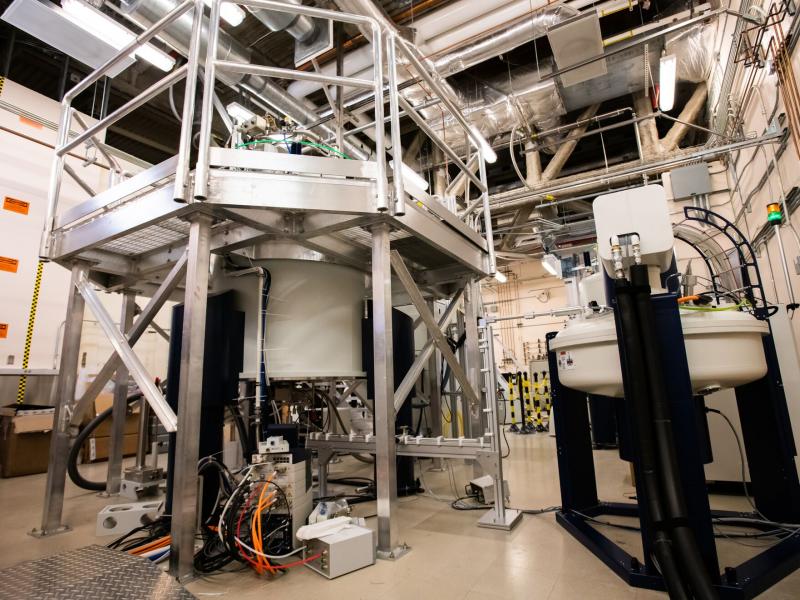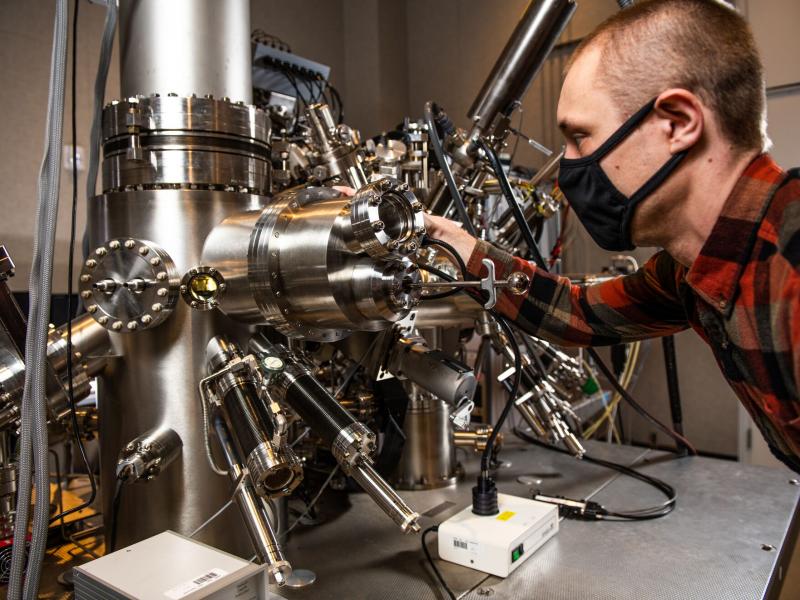A new research facility on the Richland campus of Pacific Northwest National Laboratory (PNNL) is set to open fall 2021. The Energy Sciences Center (ESC) will feature many of PNNL's strengths in chemistry, materials sciences, and computing in one building.
"The ESC will accelerate innovation in energy research using chemistry, materials science, and quantum information sciences supporting the nation's climate and clean energy research agenda," said Lou Terminello, associate laboratory director of the Physical and Computational Sciences Directorate. "This will be one of the most advanced facilities in the world designed for this type of research and will be a tremendous asset for the nation. The research that it will enable is going to play an important part in decarbonizing the energy system."
The $90 million U.S. Department of Energy (DOE) facility will help enable a clean energy future through advances in fundamental chemistry and materials science to drive the development of higher-performing, cost-effective catalysts and batteries, and other energy efficiency technologies. With cutting-edge capabilities in advanced electron microscopy, X-ray spectroscopy, and magnetic resonance methods, researchers will be able to accelerate the production of high-value sustainable chemicals and biofuels from waste carbon and other sources.
Specially designed
The ESC positions PNNL to identify, develop, and lead emerging research areas for DOE and the United States well into the future.
"Affordable, sustainable, and clean energy really is the key to addressing climate change through decarbonization of our economy," said Karl Mueller, chief science and technology officer for PNNL's Physical and Computational Sciences Directorate. "The research we will be doing in ESC focuses on discovering new routes to chemical conversions and developing new materials for energy storage, which complements the work PNNL has performed for decades. We will be better equipped to make new scientific discoveries that contribute directly to efforts to avoid climate change."
The building was specifically designed to meet the DOE's high-performance sustainable building standards. The facility features an energy- and water-reducing design that incorporates ample natural light, and pipes in waste heat energy generated by high-performance computers housed in an adjacent building. This design lays the groundwork for a future heat-sharing network that can be part of the broader campus infrastructure.
The 140,000-square-foot facility also features a combination of research laboratories, flexible-use open spaces, conference rooms, and offices for around 200 PNNL researchers, visiting scientists and engineers, and support staff.
Accelerating scientific discovery
Inside the ESC, the workspaces will be set up to allow scientists and engineers to easily share ideas, understanding, and knowledge that can ultimately be applied to advanced energy technology development.
Physical Sciences Division Director Wendy Shaw noted how the ESC's design will assist with innovation. "We put a lot of thought into how the configuration of the ESC can drive the impact of our science. It will be the first time we will have the whole research continuum-chemistry, materials science, and computing-under one roof. Having collaboration spaces for our own staff and for visiting researchers from partner institutions is central to our vision of ESC as a place for creative thinking and risk-taking to accelerate innovation in energy."
Through these collaborations, PNNL will be able to better serve its mission and help accelerate discovery, while laying a foundation for the application of new technologies and providing research programs to develop advanced computational and data methods in chemistry and materials science.
"The ESC will allow experts in multiple different areas to work together and piece many different types of data into the larger scientific picture. We can then extract not just information, but a deeper understanding and knowledge of the system under study that is virtually impossible when you don't have this kind of opportunity for collaboration," said Nancy Washton, Catalysis Sciences group leader.
Researchers in the ESC will have access to specialized scientific instruments to propel sustainable energy solutions. The purchase of this specialized scientific instrumentation was funded by $8 million from the State of Washington's Clean Energy Fund, as well as funding from Battelle Memorial Institute and PNNL. One of the new instruments featured in the ESC will be the first commercial high-field dynamic nuclear polarization nuclear magnetic resonance (DNP-NMR) spectrometer in North America. This instrument is used to enhance low intensity signals to obtain physical and chemical information on a wide range of materials, including battery materials, minerals, soils, plant materials used for bioenergy, and catalyst systems often not observable with other techniques.
"It's very common for researchers to have access to a single type of instrument. What is much less common is to have a team of scientists who are skilled on a variety of unique instruments like those in the ESC, and also understand the global picture of the problem that is being tackled," said Washton.

Science to applications
The discoveries developed inside the ESC will impact our entire world by transforming abundant wastes into high-value fuels and materials; developing new catalysts to reduce the impact of fossil fuels on the environment; discovering cheaper, safer, and higher-performing energy storage materials; developing more energy efficient ways to produce the feedstocks for agricultural fertilizers; and advancing materials and methodology for areas as diverse as chemical separations, microelectronics, and quantum information sciences.
For example, research focused on transforming abundant wastes includes the so-called upcycling of plastics.
"In the ESC, we'll be able to search for ways to break down these plastics and reuse them by turning them into some other high value product," said Mueller.
Another key area will focus on reducing vehicle emissions. Researchers will be able to utilize one-of-a-kind setups of instruments for performing analyses of catalyst materials under operating conditions that can't be found in a single facility anywhere else.
"We look at these chemical and materials systems and operate them in the laboratories as if they were being operated in a vehicle or some industrial process," said Mueller. "This allows us to build a bigger systematic approach to the problem and look for the connection between fundamental science and applied solutions. The resources in the new facility open up so many possibilities. It's very exciting for everyone looking to advance research and development for addressing major challenges for our nation."
Leadership and collaborations
The ESC will facilitate collaborations with other institutions-including with our long-standing partners from the University of Washington and Washington State University-and will spur new partnerships with other research institutions around the world. These partnerships and collaborations elevate the scientific impact and productivity of researchers through fostering collaborative research opportunities, deepening and broadening capabilities, and facilitating transdisciplinary research.
"Over the past five years, PNNL has focused on developing a variety of university partnerships through joint appointments, joint research institutes, and student internships," said Shaw. "The ESC gives us a new set of resources for use on our work, as well as the work of many of our collaborators. The capabilities we'll have are going to be a major draw for our current partners and researchers around the world working in the energy field, and for advancing scientific discovery in energy sciences."
Workers are now buttoning up the exterior of the ESC and beginning on the interior-electrical, mechanical, plumbing, interior walls, and finishes. If all goes according to plan, more than 200 PNNL staff and collaborators will be able to move into the building in the fall.







